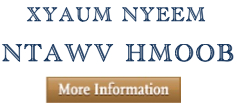History in Laos
IN THIS SECTION
Minority Polices and the Hmong in Laos
The Hmong first migrated to Laos from China and North Vietnam in the early years of the nineteenth century. Yang Dao places the earliest arrivals between 1810 and 1820 (1). By 1850, they are said to have established themselves in many scattered settlements (2). A French expedition up the Mekong River into Yunnan in 1883 estimated that they had moved to Luang Prabang province less than ten years before (3). This last reference must have been to the later and larger waves of refugees from China, as a result of more than two decades of uprisings against the Chinese, culminating in the Hmong’s suppression “with truly barbaric cruelty” by Chinese troops (4). This defeat led to massive population movements southwards. In Laos, the Hmong settled in the highlands of Houa Phan and Xieng Khouang, gradually spreading westward to Luang Prabang, Nam Tha and Sayaboury. In the early 1970s, in all these provinces they totalled some 293 000 persons (5). For reasons which will be given later, the Hmong of Xieng Khuang have played the most significant role in Lao politics beyond the village level. This is true in particular of the Hmong in Nong Het, adjacent to the border of Laos and Vietnam. After their peaceful settlement in the area towards the latter half of last century, a few of their leaders were elected as “kiatong”, to administer members of their own clan (6). Thus there were kiatong for the Lo, Lee, Yang, Vang and Moua clans, with minor leaders acting as “phutong” or heads of smaller groups.
As the French extended their rule over Laos, heavy taxes began to be imposed on the local population. A number of Hmong refused to pay these taxes, and this led to an armed clash near Ban Ban in Muong Kham, Xieng Khouang in 1896. This was probably the first instance of open resistance on the part of the Hmong since their initial settlement in Laos.
In the years that followed, the French began to intervene more and more in Hmong local affairs, either by nominating Hmong leaders as kiatong or by encouraging more interaction with other population groups. A mutual trust gradually developed between the two sides. Among the leaders during this period before the Second World War were Lyfoung and Lobliayao, the latter a kiatong in the Nong Het region and the former his son-in-law and secretary. Being more progressive and mindful of his junior status, Lyfoung sent a son of each of his three wives to school in the lowlands. They were Toulia, Touby and Tougeu, probably the first Hmong in Laos to receive formal education and later to be given positions of influence in the country’s administrative system.
The kiatong system was replaced by tasseng or canton administration in 1921, although the kiatong leaders were allowed to carry on with some of their old functions. For the strategic Nong Het area, the tasseng was administered by Song Tou, Lobliayao’s eldest son (7). In the mid-1930s, the French stationed a military officer in Nong Het, with soldiers of Lao and Vietnamese nationalities, to oversee the Hmong. In 1938, the French became dissatisfied with Song Tou and began looking for a new Hmong leader to replace him. Lyfoung, with his previous experience in local administration, offered himself for the position. The French accepted and dismissed Song Tou. Seeing the loss of such a prestigious post as a slight to the Lo clan, Lobliayao’s widow and her second son, Faydang, appealed unsuccessfully to the Chao muong (district administrator) of Muong Kham and the French commissar in Xieng Khouang. The following year, Lyfoung died and elections were held for the position of tasseng chief between Faydang and Touby, one of Lyfoung’s sons, who had just completed his secondary studies. Most Hmong voted for Touby because he was the more educated and because Faydang’s father had alienated many Hmong in the past through his authoritarian leadership.
There the matter rested until 1941, when the Japanese occupied Indochina. This new element in the situation immediately was seized upon by Faydang and the Lo clan as a means of opposing Touby’s followers and their French backers in the continuing bitter struggle between the two Hmong factions. Faydang’s men served the Japanese as guides and informers . By the same token, Faydang made early contact with the Vietminh, with whom his guerrillas joined forces to attack Touby’s pro-French partisans.
In March 1945, the Japanese reneged on their agreements with the French Vichy government, arrested many French officials in Indochina and declared an end to colonial rule in Laos. Heavily outnumbered by Japanese soldiers, a number of French officers sought refuge in isolated Hmong settlements or made their escape to China through Nong Het (9). Touby’s subordinates invariably offered them sanctuary and guides, thus attracting reprisals from the Japanese and the Vietminh. When Prince Phetsarath formed the Lao Issara front and declared Laos to be an independent monarchy, free from French control, most Hmong unwittingly found on the side of the enemy (10).
With the return of the French, (11) Touby began to organise new tassengs for Hmong settlements and to direct anti-Vietminh guerrilla warfare. He also was responsible for the strengthening of village militia units in and around the Nong Het area, in an attempt to contain military attacks from Vietminh-supported local resistance groups. Soon he was promoted to the position of Chao muong for the Hmong in Xieng Khouang, and his tasseng title passed on to one of his older half-brothers. This further committed him and his followers to an anti-Pathet Lao stance and renewed Faydang’s determination to do equally well on the other side.
READ FULL ARTICLE FROM DR. GARY YIA LEE’S WEBSITE







